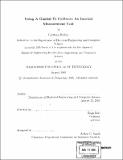| dc.contributor.advisor | Hugh Herr. | en_US |
| dc.contributor.author | Reddy, Goutam | en_US |
| dc.contributor.other | Massachusetts Institute of Technology. Dept. of Electrical Engineering and Computer Science. | en_US |
| dc.date.accessioned | 2007-04-03T17:09:08Z | |
| dc.date.available | 2007-04-03T17:09:08Z | |
| dc.date.copyright | 2005 | en_US |
| dc.date.issued | 2005 | en_US |
| dc.identifier.uri | http://hdl.handle.net/1721.1/37077 | |
| dc.description | Thesis (M. Eng.)--Massachusetts Institute of Technology, Dept. of Electrical Engineering and Computer Science, 2005. | en_US |
| dc.description | Includes bibliographical references (p. 79-82). | en_US |
| dc.description.abstract | In this thesis, an inertial measurement unit (IMU) consisting of 3 accelerometers and 3 rate gyros is created using off-the-shelf sensors from STMicro and Analog Devices. A novel technique for calibrating the orientation, position, scaling and offset of each of the sensors on the IMU is developed. A gimbal consisting of three concentric rings, with rotary encoders measuring the rotation between rings is designed. The IMU is fixed to the inner ring of the gimbal and rotated in space. By sweeping appropriate orientations of the IMU at appropriate rates, filtered sensor values can be mapped to "true" angular velocities and linear accelerations computed from the gimbal rotations. The sensor parameters are estimated via. MMSE, and a Kalman filter is implemented to estimate the IMU's attitude (roll and pitch angles) from the raw sensor values. The calibrated sensors are found to track the pitch angle with a mean-square-error of 1.7427 degrees, and the roll angle with a mean-square-error of 3.1387 degrees. The novel outcome of this thesis is that it defines a technique for calibrating IMUs with component sensors that need not be orthogonal in placement. | en_US |
| dc.description.statementofresponsibility | by Goutam Reddy. | en_US |
| dc.format.extent | 82 p. | en_US |
| dc.language.iso | eng | en_US |
| dc.publisher | Massachusetts Institute of Technology | en_US |
| dc.rights | M.I.T. theses are protected by copyright. They may be viewed from this source for any purpose, but reproduction or distribution in any format is prohibited without written permission. See provided URL for inquiries about permission. | en_US |
| dc.rights.uri | http://dspace.mit.edu/handle/1721.1/7582 | |
| dc.subject | Electrical Engineering and Computer Science. | en_US |
| dc.title | Using a gimbal to calibrate an inertial measurement unit | en_US |
| dc.type | Thesis | en_US |
| dc.description.degree | M.Eng. | en_US |
| dc.contributor.department | Massachusetts Institute of Technology. Department of Electrical Engineering and Computer Science | |
| dc.identifier.oclc | 83280846 | en_US |
